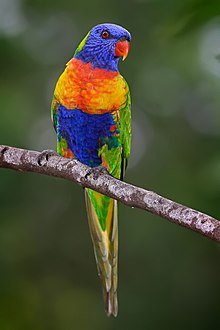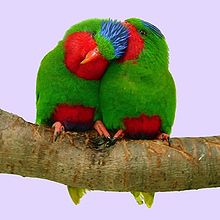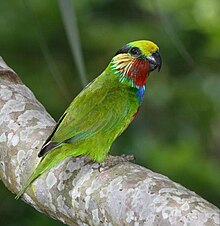
The budgerigar, also known as the common parakeet, shell parakeet or budgie, is a small, long-tailed, seed-eating parrot. Naturally, the species is green and yellow with black, scalloped markings on the nape, back, and wings. Budgies are bred in captivity with colouring of blues, whites, yellows, greys, and even with small crests. Juveniles and chicks are monomorphic, while adults are told apart by their cere colouring, and their behaviour.

The true parrots are about 350 species of hook-billed, mostly herbivorous birds forming the two superfamilies Psittacidae, and Psittaculidae, two of the three superfamilies in the biological order Psittaciformes (parrots). True parrots are widespread, with species in Mexico, Central and South America, sub-Saharan Africa, India, Southeast Asia, Australia, and eastwards across the Pacific Ocean as far as Polynesia. The true parrots include many of the familiar parrots including macaws, conures, lorikeets, eclectus, Amazon parrots, grey parrot, and budgerigar. Most true parrots are colourful and flighted, with a few notable exceptions.

Loriini is a tribe of small to medium-sized arboreal parrots characterized by their specialized brush-tipped tongues for feeding on nectar of various blossoms and soft fruits, preferably berries. The species form a monophyletic group within the parrot family Psittaculidae. The group consists of the lories and lorikeets. Traditionally, they were considered a separate subfamily (Loriinae) from the other subfamily (Psittacinae) based on the specialized characteristics, but recent molecular and morphological studies show that the group is positioned in the middle of various other groups. They are widely distributed throughout the Australasian region, including south-eastern Asia, Polynesia, Papua New Guinea, Timor Leste and Australia, and the majority have very brightly coloured plumage.

A broad-tailed parrot is any of about 35–40 species belonging to the tribe Platycercini. The members of the tribe are small to medium in size, and all are native to Australasia, Australia in particular, but also New Zealand, New Caledonia, and nearby islands.

The neotropical parrots or New World parrots comprise about 150 species in 32 genera found throughout South and Central America, Mexico, the Caribbean islands and the southern United States. Among them are some of the most familiar and iconic parrots, including the blue and gold macaw, sun conure, and yellow-headed amazon.

The purple-naped lory is a species of parrot in the family Psittaculidae. It is forest-dwelling endemic to the islands of Seram, Ambon, and perhaps also Haruku and Saparua, South Maluku, Indonesia. It is considered endangered, the main threat being from trapping for the cage-bird trade.

Vini is a genus of birds in the family Psittaculidae that are endemic to the islands of the tropical Pacific. There are eleven extant species of these small lorikeets ranging from the Bismark Archipelago through Fiji, Samoa, French Polynesia, and as far east as Henderson Island. All members of the genus have exceptional bright plumage, particularly the unusual all over blues of the blue lorikeet and the ultramarine lorikeet.

Charmosyna is a genus of parrots in the family Psittaculidae. The three currently recognized species inhabit moist forests on the island of New Guinea.
The striated lorikeet, lori strié, or lori estriado is a species of parrot in the family Psittaculidae native to New Guinea. It is the only species placed in the genus Synorhacma. It is threatened by habitat loss.
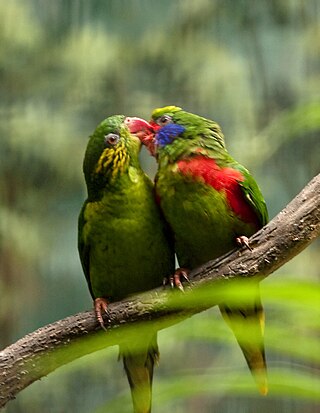
The red-flanked lorikeet is a species of parrot in the family Psittaculidae. It is found in Mollucas, New Guinea and the Bismarck Archipelago. Its natural habitats are subtropical or tropical moist lowland forests and subtropical or tropical mangrove forests. Only the adult males have the red plumage on the head and sides.
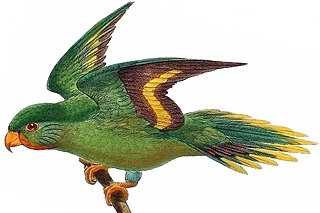
The red-chinned lorikeet is a species of parrot in the family Psittaculidae. It is native to New Britain, New Ireland, New Hannover and Karkar Island in Papua New Guinea.

The pygmy lorikeet is a species of parrot in the family Psittaculidae. It is the only species placed in the genus Charminetta. It is found in the highlands of New Guinea; its natural habitat is subtropical or tropical moist montane forests. The world population of pygmy lorikeets is thought to be less than 50,000 individuals, but stable. They live at altitudes of 1000–2200m.

The orange-billed lorikeet is a species in the Old World parrot family Psittaculidae. First described by the German ornithologist Ernst Hartert in 1896, it is endemic to New Guinea, where it mainly inhabits cloud forest, forest edges, and cleared areas bordering forests at elevations of 2,100–3,800 m (6,900–12,500 ft). Adults are 18 cm (7.1 in) long on average and weigh 25–40 g (0.88–1.41 oz), and are mainly green in color, with a red underside and narrow yellow streaking on the cheeks. It looks similar to the closely related yellow-billed lorikeet, but is smaller in size, has more richly coloured plumage, and has a smaller, orange bill.

The ornate lorikeet, sometimes named the ornate lory, is a species of parrot in the family Psittaculidae. It is endemic to the Sulawesi archipelago in Indonesia. It is found in forest, woodland, mangrove and plantations, and is locally common.
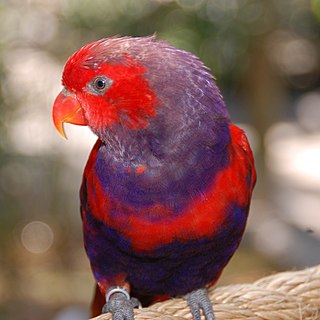
Eos is a genus of parrots belonging to the lories and lorikeets tribe of the family Psittaculidae. There are six species which are all endemic to islands of eastern Indonesia, most within very restricted ranges. They have predominantly red plumage with blue, purple or black markings. Males and females are similar in appearance.

Fig parrots (Cyclopsittini) are a small tribe of Australasian parrots in the family Psittaculidae, made up of seven species in two genera. Fig parrots are found on and around the island of New Guinea, within the territories of Indonesia, Papua New Guinea, and tropical Australia.

Birds of Eden is the world's largest free flight aviary and bird sanctuary, located in Kurland village near Plettenberg Bay in the Western Cape, South Africa. The mesh dome of the sanctuary was built over 2.3 hectares of indigenous forest, and is up to 55 metres (180 ft) above ground level. 1.2 kilometres (0.75 mi) of walkways, about 75% of which are elevated, let visitors see the birds at all levels of the aviary.

Saudareos is a genus of parrot in the family Psittaculidae. Species identified within this genus include lorikeets from the Philippines and Indonesia.

Hypocharmosyna is a genus of parrots in the family Psittaculidae that are endemic to New Guinea, the Maluku Islands and the Bismarck Archipelago.
